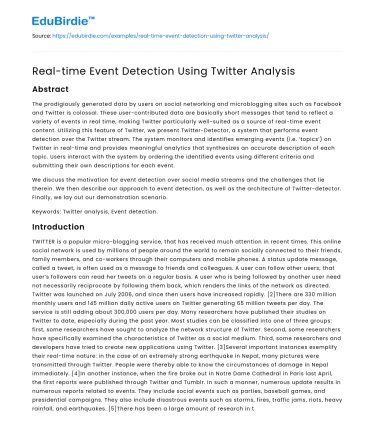Introduction
In today's digital era, the rapid dissemination of information through social media platforms has revolutionized how events are detected and reported. Twitter, with its real-time communication capabilities and vast user base, stands at the forefront of this transformation. Real-time event detection using Twitter analysis harnesses the platform's capacity to provide instantaneous insights into unfolding events, ranging from natural disasters to political upheavals. As a microblogging service, Twitter allows users to broadcast short messages or "tweets" to a global audience, enabling the rapid spread of information. The potential of Twitter as a tool for real-time event detection is substantial, given its immediacy and reach. This essay explores the mechanisms of Twitter analysis for event detection, examines real-world applications, and addresses potential challenges and counterarguments. By leveraging the wealth of information shared on Twitter, stakeholders can gain timely insights that are crucial for effective decision-making and response strategies.
Mechanisms of Twitter Analysis for Event Detection
The process of real-time event detection using Twitter involves several analytical techniques, including data mining, natural language processing (NLP), and machine learning algorithms. These methods enable the extraction and interpretation of vast amounts of data generated by Twitter users. Data mining involves collecting and processing large datasets to identify patterns and trends. In the context of event detection, it focuses on gathering relevant tweets that correspond to specific keywords or hashtags associated with particular events. For instance, during a natural disaster such as an earthquake, tweets containing keywords like "earthquake," "tremor," or location-specific hashtags can be aggregated to provide a comprehensive picture of the event's impact.
Save your time!
We can take care of your essay
- Proper editing and formatting
- Free revision, title page, and bibliography
- Flexible prices and money-back guarantee
Following data collection, NLP techniques are employed to analyze the textual content of tweets. NLP allows for the classification of tweets into categories such as positive, negative, or neutral sentiments, providing insights into public perceptions and reactions. Additionally, machine learning algorithms can be trained to recognize patterns indicative of specific events. As noted by Sakaki et al. (2010), machine learning models can achieve high accuracy in predicting the occurrence of earthquakes by analyzing the frequency and content of relevant tweets. This capability underscores the potential of Twitter analysis as a valuable tool for real-time event detection.
Real-World Applications and Benefits
The practical applications of Twitter analysis for event detection are diverse and impactful. One notable example is the use of Twitter during emergencies and natural disasters. During Hurricane Sandy in 2012, Twitter served as a critical communication channel for both affected individuals and emergency responders. As reported by Bruns and Burgess (2014), Twitter provided real-time updates on the hurricane's progression, enabling timely evacuations and relief efforts. This case highlights the platform's ability to facilitate rapid information sharing and coordination during crises.
Beyond natural disasters, Twitter analysis has been instrumental in monitoring political events and social movements. The Arab Spring, a series of anti-government protests across the Middle East, saw Twitter play a pivotal role in organizing demonstrations and disseminating information. According to Howard and Hussain (2013), Twitter enabled activists to circumvent government censorship and amplify their messages to a global audience. This demonstrates Twitter's capacity to influence political discourse and mobilize social change. Moreover, businesses and marketers leverage Twitter analysis to track consumer sentiment and brand perception. By monitoring tweets related to their products or services, companies can gain valuable insights into customer preferences and adjust their strategies accordingly.
Challenges and Counterarguments
Despite its advantages, real-time event detection using Twitter analysis faces several challenges. One significant concern is the reliability of information shared on the platform. The rapid spread of misinformation and rumors can hinder accurate event detection and lead to misguided responses. For example, during the Boston Marathon bombing in 2013, false information circulated widely on Twitter, complicating efforts to manage the crisis effectively (Starbird et al., 2014). This underscores the need for robust verification mechanisms to ensure the accuracy of information extracted from Twitter.
Additionally, the sheer volume of tweets generated daily presents a challenge in filtering relevant content from noise. Advanced filtering techniques and algorithms are necessary to distinguish meaningful information from irrelevant chatter. Furthermore, privacy concerns arise when analyzing Twitter data, as users may not consent to their tweets being used for research purposes. Addressing these challenges requires a careful balance between leveraging Twitter's potential for real-time event detection and ensuring ethical considerations and data integrity.
Conclusion
In conclusion, real-time event detection using Twitter analysis holds significant promise in providing timely insights into unfolding events. By employing data mining, NLP, and machine learning techniques, stakeholders can harness Twitter's vast information repository to enhance decision-making and response strategies. The platform's real-world applications, from emergency management to political monitoring, underscore its value as a tool for immediate event identification. However, challenges such as misinformation, data filtering, and privacy concerns must be addressed to fully realize Twitter's potential. As technology and analytical methods continue to evolve, Twitter analysis will likely play an increasingly vital role in event detection, offering a powerful means to navigate the complexities of the digital information landscape.






 Stuck on your essay?
Stuck on your essay?

